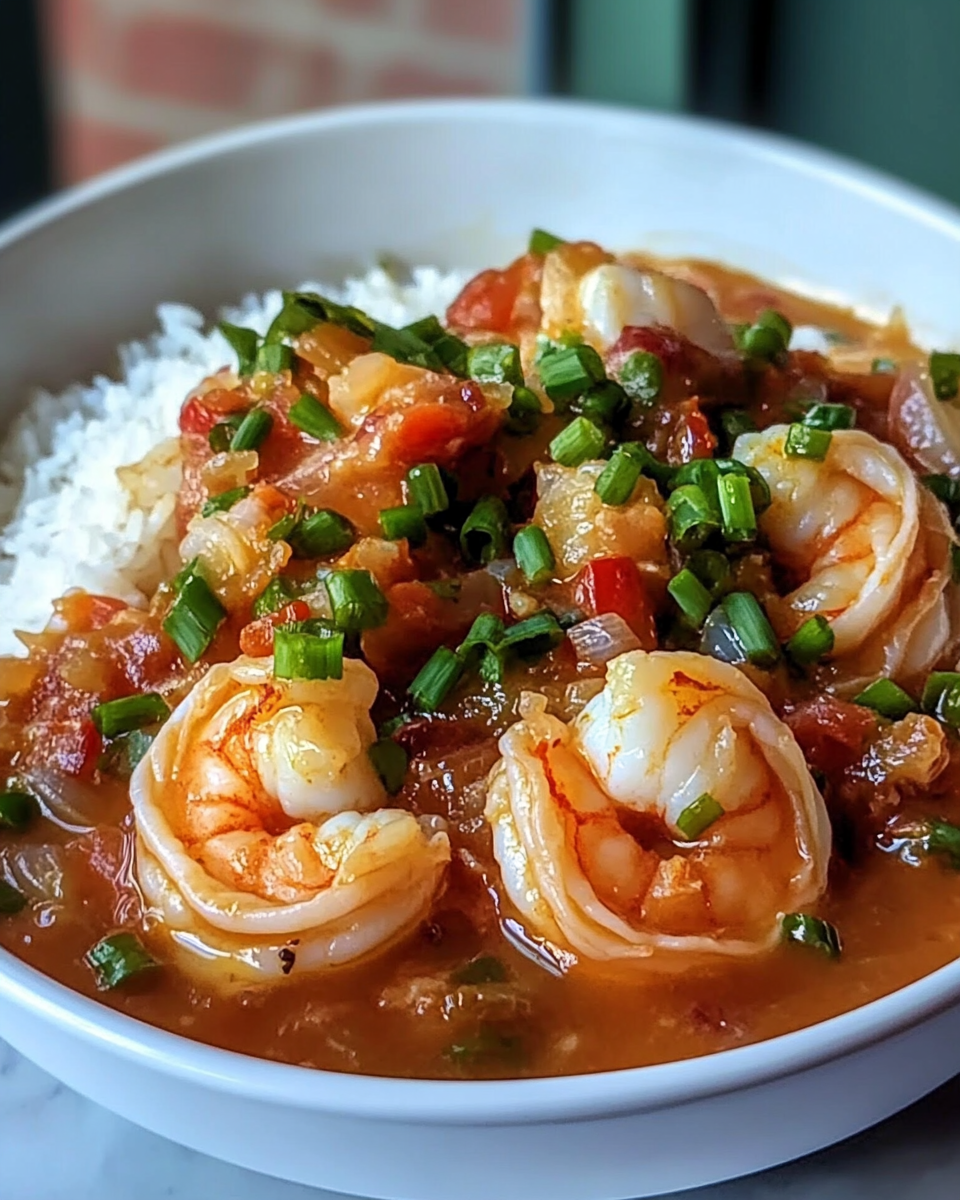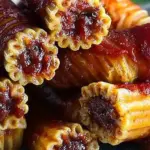This Shrimp Étouffée brings the heart of Louisiana to your table with every rich and spicy bite. The roux-based sauce, packed with tender shrimp and the “holy trinity” of Creole cooking onions, bell pepper, and celery delivers bold, deep flavors that are perfect over a steaming bed of rice. Whether you’re craving the comfort of a Southern classic or exploring new flavors, this dish is a soulful crowd-pleaser. It’s perfect for a cozy weeknight meal or an impressive weekend dinner. The best part? It’s a one-pot wonder that’s easy to make but tastes like it simmered for hours.
Full Recipe:
Ingredients:
-
1½ lbs large shrimp, peeled and deveined
-
½ cup unsalted butter
-
½ cup all-purpose flour
-
1 medium onion, finely chopped
-
1 bell pepper (green or red), finely chopped
-
2 celery stalks, finely chopped
-
4 cloves garlic, minced
-
2 tablespoons tomato paste
-
1 teaspoon smoked paprika
-
1 teaspoon cayenne pepper (adjust to taste)
-
1 teaspoon dried thyme
-
1 teaspoon dried oregano
-
2 cups seafood stock (or chicken stock)
-
2 bay leaves
-
2 tablespoons Worcestershire sauce
-
Salt and pepper to taste
-
2 tablespoons chopped green onions
-
2 tablespoons chopped fresh parsley
-
Cooked white rice, for serving
-
Fresh lemon wedges (optional)
Directions:
-
In a heavy-bottomed skillet or Dutch oven, melt the butter over medium heat. Gradually whisk in the flour to create a roux.
-
Stir continuously until the roux turns a deep golden brown, about 10-15 minutes. Be careful not to burn it.
-
Add the chopped onion, bell pepper, and celery to the roux. Cook for 5-6 minutes until the vegetables soften.
-
Stir in the garlic and cook for another minute.
-
Add the tomato paste, paprika, cayenne, thyme, and oregano. Stir to combine and cook for 1-2 minutes to release the flavors.
-
Slowly pour in the seafood stock, whisking constantly to avoid lumps.
-
Add bay leaves and Worcestershire sauce. Bring to a simmer and cook uncovered for about 15 minutes, stirring occasionally, until the sauce thickens.
-
Add the shrimp and simmer for 5-6 minutes until pink and cooked through.
-
Season with salt and pepper to taste. Remove bay leaves.
-
Stir in green onions and parsley just before serving.
-
Serve hot over a bed of fluffy white rice with lemon wedges on the side if desired.
Prep Time: 15 minutes | Cooking Time: 35 minutes | Total Time: 50 minutes
Kcal: 410 kcal | Servings: 4 servings
The Essence of Étouffée
Shrimp Étouffée is one of the most iconic and flavorful dishes to come out of Louisiana’s storied culinary heritage. This comforting stew showcases the hallmark characteristics of Cajun and Creole cooking bold spices, deep roux-based sauces, and a masterful balance of heat, richness, and umami. The word “étouffée” comes from the French word étouffer, meaning “to smother,” which is exactly how the shrimp are cooked: gently simmered in a thick, seasoned sauce and served traditionally over a bed of white rice.
The result is a dish that feels luxurious yet rustic, complex yet homey. Whether you’re a lifelong fan of Southern food or exploring regional American cuisines for the first time, Shrimp Étouffée is a must-try.
A Culinary Bridge Between Cajun and Creole Traditions
To truly appreciate Shrimp Étouffée, it’s essential to understand the culinary traditions that shaped it. Louisiana cuisine is divided mainly into Cajun and Creole styles each rooted in rich history and culture.
Creole cooking, often associated with New Orleans, is considered more refined and European in influence. It traditionally includes tomatoes, more seafood, and a broader use of spices and herbs. Cajun cooking, on the other hand, hails from the French-speaking Acadian settlers who were expelled from Canada and resettled in rural Louisiana. Cajun dishes tend to be heartier, more rustic, and use what’s readily available in the environment often one-pot meals that feed large families.
Shrimp Étouffée sits at the intersection of these two culinary philosophies. Depending on the recipe variation, it can lean Creole with a touch of tomato paste and complex herb blends or take a Cajun turn with a darker roux and more pronounced spice.
The Heart of the Dish: The Roux
Central to any great Étouffée is the roux a cooked mixture of flour and fat (usually butter or oil) that acts as the dish’s flavor and thickening base. The depth of flavor in a good Étouffée comes from the color and cooking time of the roux. Unlike a blonde roux used in French béchamel sauces, Étouffée calls for a dark, nutty roux that develops as it’s stirred slowly over medium heat.
This step demands patience and attention. A well-executed roux brings a deeply toasty, almost caramelized base to the dish that no seasoning or shortcut can replicate. It’s this dark roux that gives Shrimp Étouffée its signature richness and earthy flavor.
The Holy Trinity: Louisiana’s Flavor Foundation
No discussion of Louisiana cooking would be complete without mentioning the “Holy Trinity” onion, bell pepper, and celery. These three vegetables form the aromatic base for most Cajun and Creole dishes, similar to the role of mirepoix in French cuisine.
In Shrimp Étouffée, the Holy Trinity is sautéed in the roux, releasing their fragrance and creating a base layer of flavor. Combined with minced garlic and herbs like thyme, oregano, and bay leaves, the dish becomes deeply aromatic, soulful, and unmistakably Southern.
The Shrimp: Fresh, Tender, and Full of Flavor
As the name suggests, shrimp are the star of this dish. While you can find many versions of Étouffée made with crawfish or chicken, shrimp remains a favorite for its availability and fast cooking time. Using large, fresh Gulf shrimp is ideal, as they hold their texture and absorb the sauce beautifully.
The shrimp are added toward the end of the cooking process to prevent them from overcooking. They simmer gently in the gravy, absorbing all the savory, spicy notes of the sauce while maintaining their natural sweetness and succulence.
Variations of Shrimp Étouffée
Like many classic recipes, Shrimp Étouffée has regional and household variations. Here are a few popular ones:
-
Crawfish Étouffée: Often considered the original version, especially in Cajun regions. The method is the same, but the flavor of crawfish adds a more distinct and briny profile.
-
Tomato-Based Étouffée: More common in Creole cooking, this version includes tomatoes or tomato paste for a slightly sweeter, more acidic sauce.
-
Creamy Étouffée: Some modern twists include a splash of cream or milk to mellow the spice and add richness.
-
Spicy Étouffée: For those who love heat, adding extra cayenne or hot sauce turns this into a fiery feast.
Regardless of the variation, the heart of the dish remains the same: a luscious, roux-based gravy that “smothers” the shrimp in flavor.
Perfect Pairings and Serving Suggestions
Traditionally, Shrimp Étouffée is served over steamed white rice, which acts as the perfect neutral base for soaking up all the saucy goodness. However, you can pair it with:
-
Dirty rice or butter rice for extra flavor
-
Cornbread or buttermilk biscuits on the side
-
A light collard green or kale salad to balance richness
-
A cold lager or pale ale to contrast the heat
-
Sweet iced tea or lemonade for a Southern refreshment
For a complete Louisiana-themed meal, serve Shrimp Étouffée as the main course followed by a dessert like pecan pie, beignets, or bread pudding.
Tips for Making the Best Shrimp Étouffée
Here are a few tips that can elevate your Shrimp Étouffée to restaurant-quality:
-
Don’t rush the roux: This is the most crucial part of the flavor-building process. Stir slowly and constantly to avoid burning.
-
Use fresh shrimp stock: If you have access to shrimp shells or heads, simmer them with water, onion, and herbs for a homemade seafood stock. It adds incredible depth.
-
Let the flavors meld: After cooking, allow the dish to rest for a few minutes before serving. This lets the spices settle and blend more harmoniously.
-
Adjust heat to your liking: Start with a moderate amount of cayenne and increase to taste. You want a warming kick, not overpowering heat.
-
Garnish smartly: A sprinkle of chopped parsley and green onions just before serving adds a fresh contrast to the rich sauce.
Why Shrimp Étouffée Deserves a Spot on Your Table
Shrimp Étouffée is more than just a dish it’s an expression of culture, heritage, and soulful cooking. It’s a testament to how humble ingredients flour, butter, vegetables, and shrimp can be transformed into something extraordinary with time, care, and tradition.
This dish invites you into the heart of Louisiana with each bite, where every household may have its own twist, but the soul of the dish remains unmistakable. It’s comforting enough for a chilly evening, bold enough for a weekend dinner party, and simple enough for a weeknight indulgence.
Conclusion:
In the world of Southern cuisine, Shrimp Étouffée is a crown jewel a dish that embodies the rich flavors, history, and warmth of Louisiana. Whether you’re making it for the first time or it’s already part of your family’s tradition, this dish delivers satisfaction on every level.
From the deep, flavorful roux to the tender shrimp and aromatic vegetables, it’s a perfect symphony of spice and comfort. Serve it with love, and you’ll understand why it continues to stand the test of time as one of the South’s most beloved dishes.






